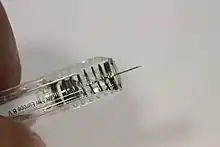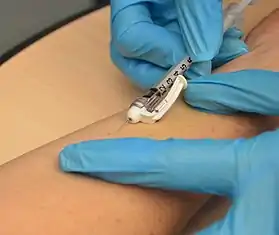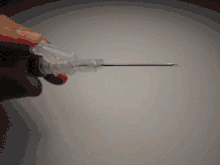Safety syringe
A safety syringe is a syringe with a built-in safety mechanism to reduce the risk of needlestick injuries to healthcare workers and others. The needle on a safety syringe can be detachable or permanently attached. On some models, a sheath is placed over the needle, whereas in others the needle retracts into the barrel. Safety needles serve the same functions as safety syringes, but the protective mechanism is a part of the needle rather than the syringe. Legislation requiring safety syringes or equivalents has been introduced in many nations since needlestick injuries and re-use prevention became the focus of governments and safety bodies.

Types
There are many types of safety syringes available on the market.[1] Auto Disable (AD) syringes are designed as a single use syringe, with an internal mechanism blocking the barrel once depressed so it cannot be depressed again. The other type of syringe with a re-use prevention feature is the breaking plunger syringe. An internal mechanism cracks the syringe when the plunger is fully depressed to prevent further use. These syringes are only effectively disabled with a full depression of the plunger; users can avoid activating the re-use prevention feature and re-use the syringe.

The more effective safety syringes have reuse and needlestick prevention features. A sheath or hood slides over the needle after the injection is completed with a Needlestick Prevention Syringe, which also has a re-use prevention feature (either an auto disable mechanism or breaking plunger). Retractable syringes use either manual or spring-loaded retraction to withdraw the needle into the barrel of the syringe. Some brands of spring-loaded syringes can have a splatter effect, where blood and fluids are sprayed off the cannula from the force of the retraction. Manual retraction syringes are generally easier to depress because there is no resistance from a spring.

Alternatives
Traditional glass syringes can be re-used once disinfected. Plastic body syringes have become more popular in recent years because they are disposable. Unfortunately, improper disposal methods and re-use are responsible for transferring blood borne diseases.
Importance
Of the 55 cases documented by the CDC of (non-sex work) occupational transmission of HIV, 90% were from contaminated needles that pierced the skin.[2] The direct cost of needlestick injuries was calculated in a recent study to be between $539 and $672 million US dollars.[3] That includes only lab tests, treatment, service and "other"; it does not take into account lost time and wages for employers and individuals.
Legislation
United States
- Needlestick Safety and Prevention Act, effective date 2001[4]
Two lawyers, Mike Weiss and Paul Danzinger, were approached in 1998 by an inventor, Thomas Shaw, who was having trouble selling a safety syringe developed to protect health care workers from accidentally being infected by dirty needles. The problems were due to monopolistic actions of a major industry needle maker and hospital group purchasing organizations. The case was settled before trial for $150 million.[5] This was portrayed by the 2011 movie Puncture.[6] Shaw's attempts to get his retractable needle accepted by health care facilities were covered in a 2010 Washington Monthly article.[7]
Canada
Australia
Africa
- The Nigerian government issued an October 1, 2012 deadline for phasing out of conventional syringes and usage of auto-disable syringes in its health institutions.[18]
Europe
- The European Union has some regulations on this subject.[19]
See also
- Infection control
- Peggy Ferro
References
- "WHO | Safe syringes for injection safety". World Health Organization. 2010-11-30. Archived from the original on December 14, 2007. Retrieved 2012-02-07.
- International Council of Nurses. "Health Care Worker Health and Safety: Preventing Needlestick Injury and Occupational Exposure to Bloodborne Pathogens" (PDF). World Health Organization.
- Jagger, Janine (1998). "Healthcare Direct Cost of Follow-up for Percutaneous and Mucocutaneous Exposures to At-Risk Body Fluids: Data From Two Hospitals" (PDF). Advances in Exposure Prevention. International Healthcare Worker Safety Center. 3 (3).
- 106th Congress. "Needlestick Safety and Prevention Act". U.S. Government Printing Office. Retrieved 25 February 2012.
- "Syringe Manufacturer Settles Claim of Market Manipulation". The New York Times. 2004-07-03. Retrieved 25 November 2011.
- "Puncture (2011)". IMDb. Retrieved 25 February 2012.
- Blake, Mariah (July–August 2010). "Dirty Medicine". Washington Monthly. Retrieved 19 January 2020.
- "Laboratory Biosafety Guidelines 3rd Edition 2004 – Pathogen Regulation Directorate". Public Health Agency of Canada. 2011-02-18. Retrieved 2012-02-07.
- "OHS Guidelines Part 6 Substance Specific Requirements". Retrieved 2012-02-07.
- "OCCUPATIONAL HEALTH AND SAFETY CODE" (PDF). Government of Alberta.
- "The Workplace Safety and Health Amendment Act (Needles in Medical Workplaces)". 2005-06-09. Retrieved 2012-02-07.
- "Labour Standards Information for the Restaurant and Foodservices Industry" (PDF). Saskatchewan Ministry of Labour Relations and Workplace Safety.
- "Occupational Health and Safety Act – O. Reg. 474/07". 2010-07-01. Retrieved 2012-02-07.
- "Regulations – Safer Needles in Healthcare Workplaces". Retrieved 2012-02-07.
- "Sharps Injuries – Prevention in the NSW Public Health System" (PDF). Department of Health, NSW.
- "OHS Reps @ Work : Infectious Diseases – Needlestick Injuries". 2008-02-25. Retrieved 2012-02-07.
- "OCCUPATIONAL EXPOSURES TO BLOOD AND BODY FLUIDS RECOMMENDED PRACTICES FOR PREVENTING HOLLOW-BORE NEEDLESTICK INJURIES" (PDF). Centre for Healthcare Related Infection Surveillance and Prevention.
- "The Guardian Nigeria News - Nigeria and World News | the Latest news in Nigeria and world news. The Guardian Nigeria Newspaper brings you the latest headlines, opinions, political news, business reports and international news".
- "COUNCIL DIRECTIVE implementing the Framework Agreement on prevention from sharp injuries in the hospital and healthcare sector concluded by HOSPEEM and EPSU" (PDF). COUNCIL OF THE EUROPEAN UNION.
External links
- W.H.O. Injection Safety Toolbox
- W.H.O. Injection Safety
- Centers for Disease Control – Injection Safety
• Washington Monthly, Jul/Aug 2010, "Dirty Medicine"